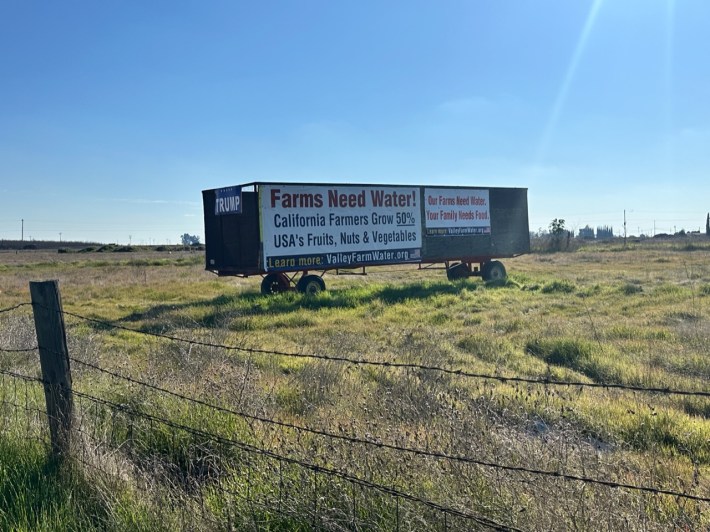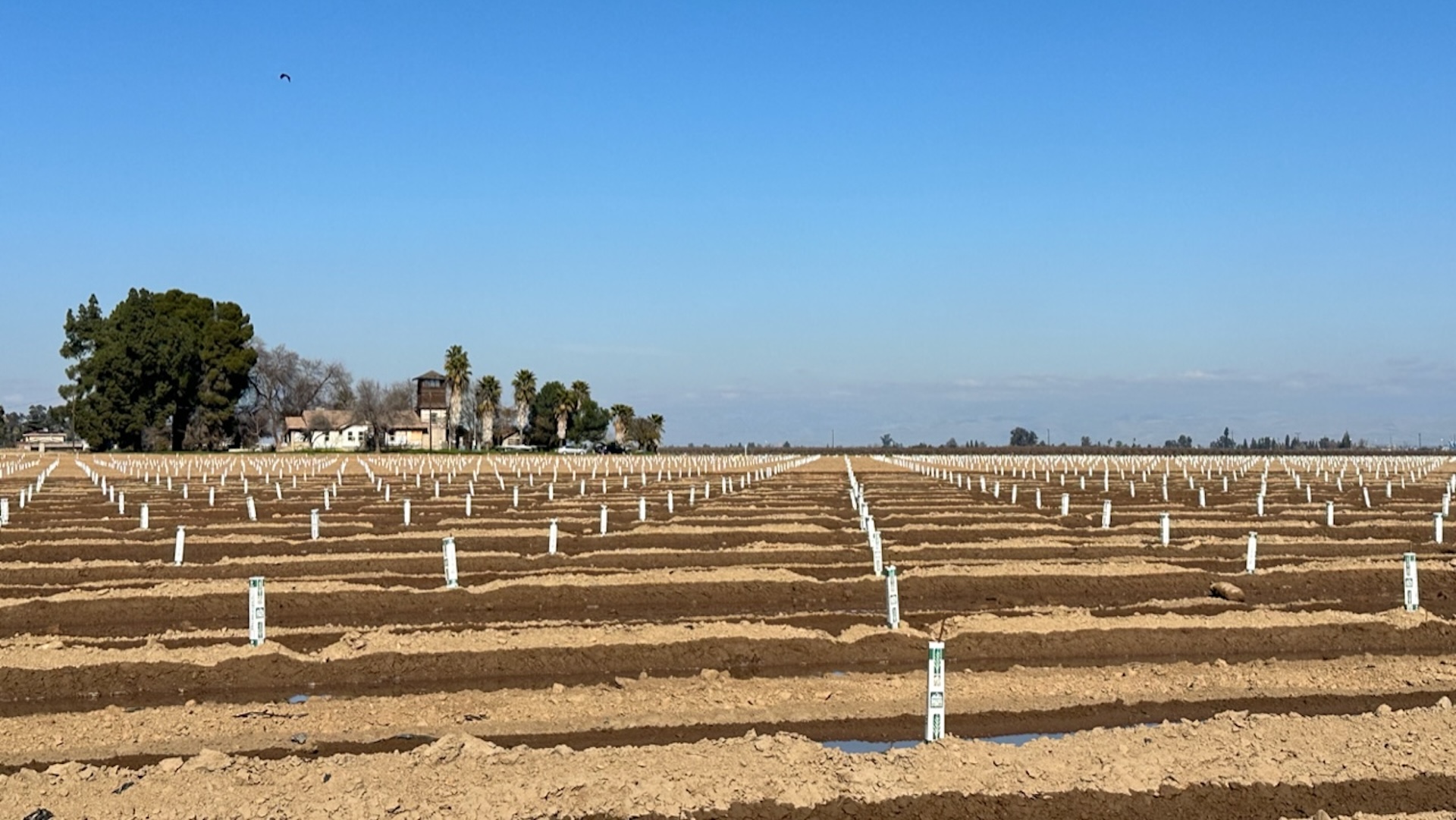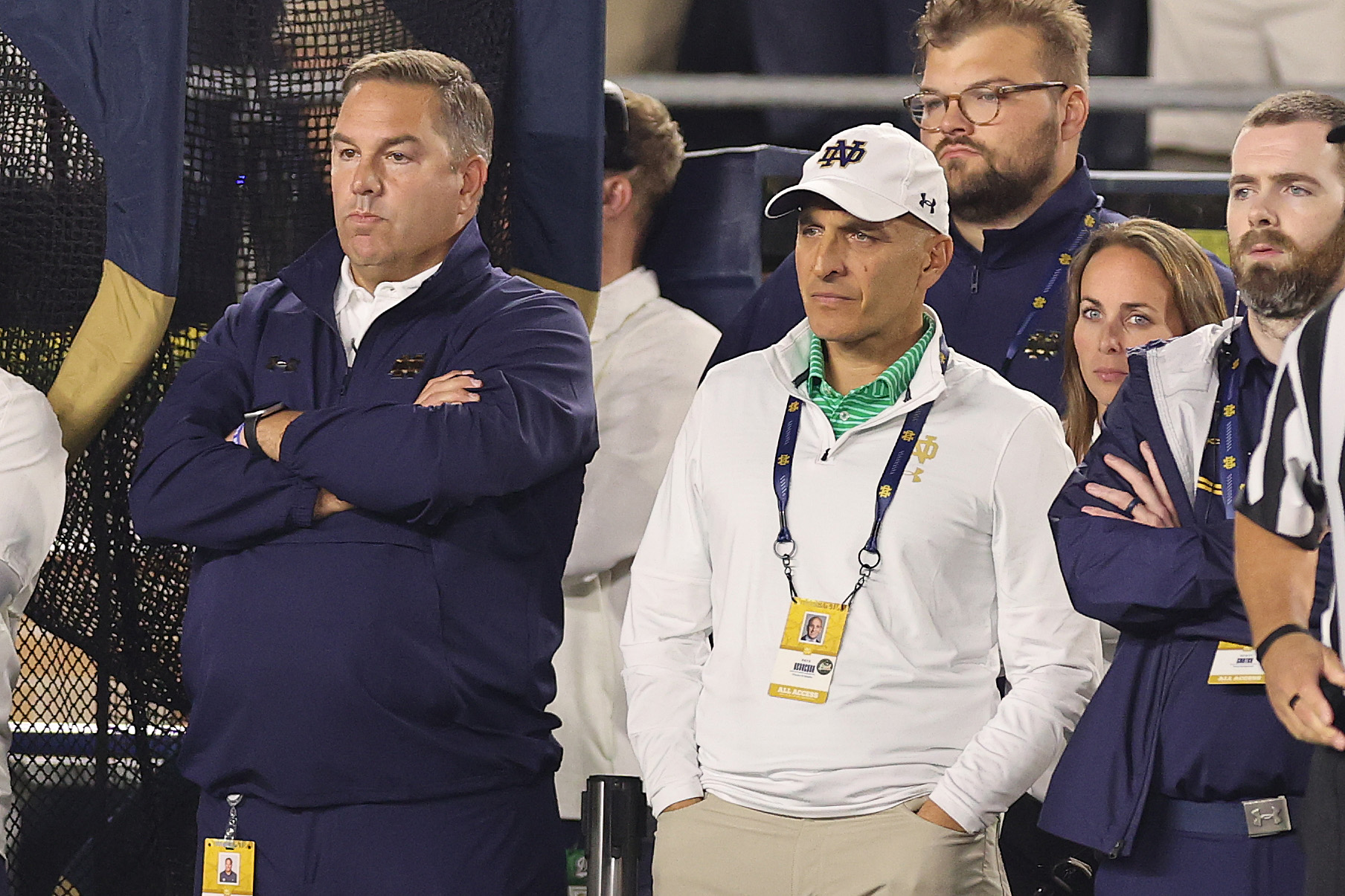Donald Trump’s last-minute decision to release water into Tulare County reservoirs as a belated solution to the fires in Southern California didn’t make much sense to anyone. The water wouldn’t actually make it to Los Angeles, and the places in the San Joaquin Valley where it was going are more at risk of flooding right now than of drying out. Even the supposed beneficiaries of the water windfall knew that gorging now meant potentially being dry during the long hot summers when they actually needed the water.
“A decision to take summer water from local farmers and dump it out of these reservoirs shows a complete lack of understanding of how the system works and sets a very dangerous precedent,” Dan Vink, a longtime Tulare County water manager, told SJV Water.
And yet the move, badly timed and ill-conceived though it was, did have a sick sort of logic to it. At least, it would for anyone who has seen certain signs dotting the highways and interstates throughout California’s Central Valley (which traces a vertical swatch through the state’s navel, from Stockton in the north to Bakersfield in the south). “NEWSOM: Stop Wasting Our Dam Water!” they scream in banners tacked to parked trailers. “Farms Need Water!” “Stop Dumping Our Farm Water & Jobs In The Ocean!” and so forth.

Driving through the middle of the state—and driving is how the majority of Californians experience the Central Valley, unless you actually live there, like me—the signs are impossible to miss. And if you only got your news from roadside signs, you might be convinced of a grand Democrat-led conspiracy to take perfectly good water and “dump” it in the ocean—either out of a desire to stick it to salt-of-the-Earth farmers or some misguided environmentalist-led concern for “worthless fish,” as farmers here and now Trump have long called the Delta Smelt, one of the California’s now-nearly extinct freshwater fish species.
This, apparently, was the dominant narrative that had lodged in President Trump’s brain in the wake of the wildfires tearing through Los Angeles last month. The Democrats had broken California and he was going to fix it. As he wrote on Truth Social, "The United States Military just entered the Great State of California, and, under Emergency Powers, TURNED ON THE WATER flowing abundantly from the Pacific Northwest, and beyond. The days of putting a Fake Environmental argument, over the PEOPLE, are OVER. Enjoy the water, California!!!"
Trump’s invocation of “The United States Military” apparently referred to the Army Corps of Engineers, who were in charge of implementing the plan, whose details are still evolving. Tulare County locals (pronounced “to-LARRY,” for you outsiders) were reportedly “sent into a mad scramble,” begging the Corps to lower the amount of water being released to avoid causing a flood. Trump trying to send billions of gallons of water to people now begging him to stop only makes sense in the broader context of a supposed grand conspiracy to withhold water because of some radical anti-growth ideology—something Central Valley farmers have been alleging for years.
Water politics in California is fertile ground for conspiracy theories, given that most of the state’s water is organized into a complex network of dams, reservoirs, man-made lakes, canals, and rivers, and is doled out according to secretive deals that most of us aren’t privy to. A complex deal struck in the mid-1990s essentially privatized a big chunk of it. Yet if you grew up here, California’s massive man-made water network has always just been here—big, straight streams you cool off in during the summer, or drink beer next to as a high school kid. Water politics, and our entire water system, remain mostly in the background. It’s only when some kind of disaster hits, like the recent fires in L.A., that people suddenly remember the system exists.
To state what is hopefully obvious to most people: California has not been “diverting” fresh water into the ocean. Into the ocean is the way fresh water naturally flows. What’s also true, however, is that most of California’s water hasn’t naturally flowed for at least 100 years, ever since the state’s early planners built the massive network of dams, canals, aqueducts, tunnels, and pumps, without which most of California’s agriculture industry and suburban development wouldn’t exist at all. We have also pumped out so much of that groundwater that parts of the Central Valley are physically sinking, at a rate of a foot per year. Very little of the state’s water flow has been “natural,” in any sense of the word, for a very long time.
One journalist who has been following the story of California’s strange water networks and the people who control them is Yasha Levine, the Soviet-born, San Francisco-bred co-director (with Rowan Wernham) of the new documentary Pistachio Wars. Recently released early for a limited time thanks to the interest generated by the fires, the doc sets out to explain some of what so many of us have either taken for granted about California’s water system or deliberately mischaracterized for political ends.
“If it wasn't stealing water from places that were hundreds of miles away, L.A. would still be a fairly small city,” Levine tells me. “There's water, there's the L.A. River, there's underground water supplies. You could probably have a decent small city on that, but you would never be able to have the civilization, really, that has two thirds of the population of California in it.
“I call what California has ‘a terraforming project,’ because it is almost like a planet-altering system that reverses rivers, redirects streams, and pumps water up mountains rather than letting it flow into the ocean.”
It’s easy to dunk on Trump and Trumpists for their crude mischaracterizations, but few people seem to grasp the scale or complexity of the California water project. While the fires were still raging, many leftists and liberals blamed the Resnicks—the Beverly Hills billionaire power couple who own the Wonderful Company, Fiji Water, Teleflora, and a handful of other empires—for hoarding water that should’ve gone to fire hydrants and trucks working to put out fires in Pacific Palisades and Altadena.
Whatever you think about the Resnicks, the truth is, it would be impossible to hoard the amount of water it would’ve taken to put out all the L.A. fires. Climate change has made those otherwise naturally occurring fires more frequent and more intense, and poor suburban planning has kept the state from allowing the kinds of smaller fires and controlled burns that the state’s earlier native inhabitants used to manage flammable brush and mitigate damage. But once a massive fire starts burning, there’s a low limit to what hoses can do.
Even if this one wasn’t on them, it’s also true that Stewart and Lynda Resnick wield disproportionate control over a state water supply that has been largely privatized, divvied up between cronies over multiple generations, and generally controlled in an opaque manner despite it affecting us all. That was part of the inspiration for Pistachio Wars. In his voiceover in the film, Levine notes that the Resnicks “own more water than anyone on the planet.”
And this, the film boldly presupposes, might be a bad thing.
The Resnicks have pushed back against related claims in a series of fact-checking articles that usually quote Resnick spokesmen. Yet even their denials acknowledge that the Resnicks control a large quantity of water. They have, for instance, at times sold water back to the state at a profit. The fact-checkers would note that the Resnicks actually control “a 57 percent stake in the Kern Water Bank,” which itself accounts for only a fraction of the state’s total supply.
Of course, even that figure is controversial, because as the Fresno Bee noted, ownership of the Kern Water Bank “has been controversial since the 1990s when it was deeded to the Kern County Water Agency from the state and then immediately turned over to the authority, which is, arguably, controlled by one private individual – Stewart Resnick.”
“The details are a little boring, but the Resnicks essentially helped to privatize and deregulate the state-controlled water delivery system,” Levine says. “And by doing so, they became kind of almost like water barons, who have an allotment of water, and that water they can use to either farm or to sell to other cities if they need it. Let's say if Los Angeles is running low on water, the Resnicks could sell their water to L.A. rather than use it to grow crops if it made economic sense for them. They've got their hands on this water supply through the classic ‘90s pattern of deregulation and neoliberalism.”
Just who the hell the Resnicks are and how all these water rights work is a big part of the story Levine and Wernham attempt to tell in Pistachio Wars. The classic story is of California’s interest groups and regions pitted against each other in a zero-sum game—developers vs. farmers, urban lawns vs. rural orchards, California’s people vs. California’s fish—yet the Resnicks themselves are a sort of microcosm of the cozy connections between the power factions.
“The Resnicks are just a couple that really wanted to succeed at business when they met in LA in the ‘70s,” Levine says. “They tried their hand at different things, like selling trinkets and flowers and all sorts of things. They became farmers almost by accident, because they bought some land as a way of diversifying.”
Lynda Resnick came from the Hollywood side, born to a movie-producer father, Jack Harris, who produced the cult hit The Blob. She at one point was dating a friend of Pentagon Papers leaker Daniel Ellsberg, and the two reportedly used Lynda’s office at her ad agency to make photocopies. Stewart had started a janitorial business while he was in law school, which grew fast enough to make him a millionaire before he graduated. He also started a security company that at one point had the contract for security at the international terminal at LAX, employing former secret service agents and the ex-chief of the LAPD. At one point, three of his guards got caught smuggling heroin. He grew up in New Jersey, where his father “was a drinker, a gambler and had close ties to the criminal underworld and the Jewish mob.”
The two met while Lynda was working on one of Stewart’s accounts, and their backgrounds seemed to complement each other perfectly. They started buying up farmland in the Central Valley in the late ‘70s, and “by 1996, their agricultural company, Paramount Farms, had become the world’s largest producer and packager of pistachios and almonds, with sales of about $1.5 billion.”
“Lynda, who is this kind of marketing genius,” Levine says, “realized, wait a second, we have some pomegranates, some pistachios, some almonds—we have some oranges and things like that. These things aren't branded usually, but we can brand what used to be generic produce, and use modern marketing techniques to sell them to people.”
So it is that we have The Wonderful Company, selling pomegranate juice (POM Wonderful), mandarin oranges (Halos), and, notably, pistachios. As Levine notes in the film, pistachios are grown thanks to the massive man-made water system, but have become big business largely thanks to a sort of artificial market created by the sanctions regime against Iran following the Iranian revolution in 1979.
“Because Iran has historically been the number one global exporter of pistachios, the fact that the American market was sort of shielded from Iranian pistachios created an opportunity for farmers in California,” Levine says. “That's the origin of the American pistachio industry—as kind of blowback from the CIA's meddling in Iran.”
Indeed, the Resnicks, who reportedly control 60 percent of the U.S. pistachio industry and make 20 percent of their income from them, have donated and been part of a number of organizations defined by their hawkish stances on Iran—from the Washington Institute for Near East Policy to the American Friends of IDC to the American Jewish Committee. It’s only by contextualizing the pistachio market that Pistachio Wars is able to make sense of the Resnicks’ convoluted politics.
These are the kinds of connections that exist between global politics, neoliberal deregulation, and water allocation in obscure places in the San Joaquin Valley that only seem to make news during fires or droughts. But as Levine and Pistachio Wars make clear, these systems are allowed to persist partly because no one pays attention to them.
“Pistachios get at the absurdity of the system of how resources get allocated, why certain crops are grown and some crops are not grown, and who ultimately makes the decisions of what kind of food is produced in America,” Levine says.
In Pistachio Wars, Levine’s research takes him to Lost Hills, a city about 50 miles northwest of Bakersfield that has little in the way of infrastructure, but a new public park with cheerful POM Wonderful branding, courtesy of the Resnicks. They tout it as part of their philanthropic endeavors to give back, all in keeping with one of Lynda’s favorite quotes, about “doing well by doing good.”
Unfortunately, the splash area portion of the park (very important in the Valley’s near constant triple-digit summers) was closed during Levine’s visit, the pipes having rotted away thanks to the concentration of chemicals in the water. Pistachio Wars depicts Lost Hills as one loser in California’s water game, with the Resnicks having been allowed (partly thanks to the water privatization system and its ability to avoid public scrutiny) to use water contaminated by old oil drilling to feed their orange and pistachio trees. Even if the trees don’t mind, those contaminants tend to leech into the water supplies of places like Lost Hills, where they pose risks to the local populations. The locals can get angry about this, but Pistachio Wars reminds us that an important part of the Resnicks’ power over the region is that in addition to water rights, they control a lot of people’s jobs. According to the New York Times, one out of every two Lost Hills households contains someone who ends up working for the Resnicks.
Water is a peculiar commodity in California, treated in so many ways like money despite not entirely functioning like it, and creating cycles of blame about who is “hoarding” or “wasting” it. In California, “wasting” water means letting it do what water naturally does—flow from rivers into the sea.
“Allowing nature to happen, that’s like a giant crime to them,” Levine says. “It’s a crime for farmers, because to them, every drop of that water is money. It's crops that they can plant. For real estate developers who are building suburbs out in the semi-arid regions of California, that water is also money because you can't build a subdivision out somewhere on the fringes of Southern California without access to water. And so for the people who control the state—real estate interests and agricultural interests—for them, letting nature run its course is like a crime against capitalism, against the economy, against the American people.”
If you’ve seen Chinatown or spent time in any of those arid subdivisions, you might get the idea that it’s all that sprawl that’s sucking an already dry state even drier. Makes sense; it’s easy to hate ugly subdivisions. While it’s true that countless ugly McMansion grids are an insult to God in a state that gets its very nickname (“The Golden State”) from the abundance of dead grass, it’s also true that 80 percent of California’s fresh water goes to agriculture. Meaning that, as Levine points out, even if all of California’s actual residents disappeared overnight, we'd only save at most 20 percent of the state’s total water.
In another telling vignette in Pistachio Wars, Levine goes to East Porterville, a town that was making news in the late aughts and early 2010s when, in the midst of a drought, people’s wells, the source of all their houses’ running water, were running dry. Yet, as Levine and Wernham found, the drought was only part of the story. There was water there, and the drought meant that there was less of it, but that scarcity only seemed to be affecting the poorer residents.
“We found that yes, the drought was to blame, but it was because a handful of the powerful people in this little tiny town had effectively become the Resnicks on a smaller scale, privatizing the local water supply,” Levine says. “These were frequently big landowners who owned land going back over a century. They owned land there when a local dam was built, and after the dam was built, they had all the rights to the water that this dam was able to store.
“They essentially took what was legally theirs; they weren't doing anything illegal, but that had a consequence in that water was not being allowed to naturally seep underground like it normally would, and so that was what was causing everyone's wells to run dry.”
This is partly why simply stating that someone like the Resnicks owning “57 percent of a water bank” doesn’t always tell the whole story. It attempts to treat water according to the rules of capital, where they often don’t apply.
“This, for us, was a little microcosm of what's happening in the entire Southwest. The water rights water are controlled by like a landed elite—farmers, real estate developers,” Levine says. “And in times when there's plenty of water in the wet years, it doesn't seem like there's any problem. But as soon as the supply starts to get taxed, you realize that, wait a second, they have the rights to all the water. And then everyone else is just downstream from it and is at their mercy.”






